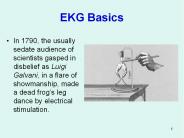The EKG - PowerPoint PPT Presentation
1 / 13
Title:
The EKG
Description:
understand how cellular action potentials give rise to a signal ... understand the origin of the main phases of electrocardiogram (EKG) The Heart. is a pump ... – PowerPoint PPT presentation
Number of Views:80
Avg rating:3.0/5.0
Title: The EKG
1
The EKG
- Physiology in action
2
Objectives
- understand basic cardiac anatomy
- understand how cellular action potentials give
rise to a signal that can be recorded with
extracellular electrodes - understand the path for action potential
propagation through the heart - understand the origin of the main phases of
electrocardiogram (EKG)
3
The Heart
is a pump
has electrical activity (action potentials)
generates electrical current that can be measured
on the skin surface (the EKG)
4
Currents and Voltages
- At rest, Vm is constant
- No current flowing
- Inside of cell is at constant potential
- Outside of cell is at constant potential
0 mV
5
Currents and Voltages
- During AP upstroke, Vm is NOT constant
- Current IS flowing
- Inside of cell is NOT at constant potential
- Outside of cell is NOT at constant potential
An action potential propagating toward the
positive ECG lead produces a positive signal
Some positive potential
6
More Currents and Voltages
------------------------
7
More Currents and Voltages
Repolarization spreading toward the positive ECG
lead produces a negative response
8
The EKG
- Can record a reflection of cardiac electrical
activity on the skin- EKG - The magnitude and polarity of the signal depends
on - what the heart is doing electrically
- depolarizing
- repolarizing
- whatever
- the position and orientation of the recording
electrodes
9
Cardiac Anatomy
Superior
vena cava
Pulmonary veins
Atrioventricular (AV) node
Sinoatrial (SA)A node
Left atrium
Atrial muscle
Mitral valve
Tricuspid valve
Purkinje fibers
Ventricluar
muscle
Descending aorta
Inferior vena cava
10
Flow of Cardiac Electrical Activity
SA node
AV node (slow)
Purkinje fiber conducting system
Ventricular muscle
11
Conduction in the Heart
0.12-0.2 s
approx. 0.44 s
SA
node
Atria
AV
node
Purkinje
Ventricle
12
The Normal EKG
Right Arm
Lead II
Left Leg
13
Action Potentials in the Heart
AV
Purkinje
Ventricle














![[PDF] DOWNLOAD EKG/ECG Interpretation Made Simple: A Practic PowerPoint PPT Presentation](https://s3.amazonaws.com/images.powershow.com/10084407.th0.jpg?_=20240724031)
















